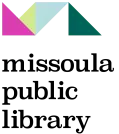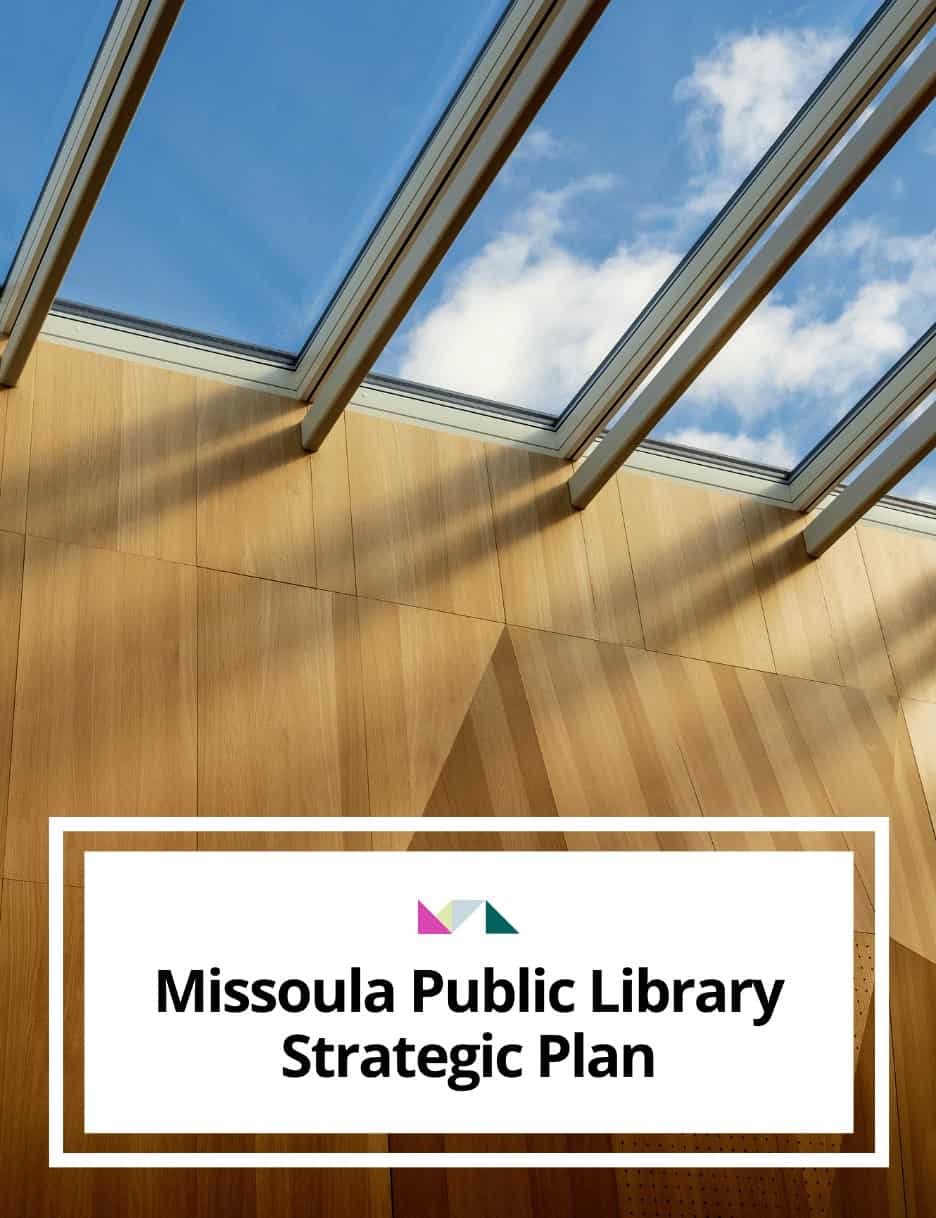Strategic Plan
Our Mission
Spark Curiosity. Make Connections. Thrive Together.
Our Vision
Missoula County is vibrant, creative, and healthy. MPL gives compassionate, inclusive service to all and is the first place everyone goes to learn, engage, innovate, and have fun.
Our Values
Access
- We put people at the heart of all we do
- We support discovery and lifelong learning
- We commit to equitable access for all
Innovation
- We anticipate changes and challenges and respond with agility
- We celebrate the creativity of staff and patrons
- We consider sustainable practices as core to our identity
Integrity
- We act in ways that foster trust and confidence
- We are accountable to the community and to each other
- We abide by the ethical principles that define modern librarianship
Kindness
- We promote the well-being of staff and the community
- We treat all people with compassion
- We seek to understand the needs of the people we serve
Reflection
- We reflect the diversity of our community
- We actively listen to our community
- We are intentional in our actions and decisions
Our Strategic Priorities
Community members express that they experience isolation, siloing of resources, the need for connection, and lack of time to visit the Library. Missoula Public Library will extend the Library’s reach to underserved and geographically isolated populations by leveraging its branch network, developing new community resources, and expanding on the downtown flagship’s “all under one roof”1 model.
Goal: Intentional services to priority communities2 through outreach
- Assess greatest community needs in context of projected Library capacity
- Determine and assign funding sources/uses for new outreach initiatives
Unveil first resource for expanded cross-town or rural Library access and launch first program/service for underserved population (e.g. Bookmobile)
Goal: More welcoming spaces for Indigenous community members, teens, refugees/immigrants, and people with disabilities
- Co-create with priority communities to determine what modifications are needed and what additions would be helpful.
- Expand access by bringing elements of MPL to locations outside of the libraries through outreach (e.g. activities at Kyiyo Pow Wow) and passive programs (e.g. mini libraries at laundromats).
- Allocate more resources to branches for improvements, programs, collections, and signage.
- Provide staff training opportunities with an emphasis on equity, diversity, and inclusion and apply concepts to work tasks.
Goal: Diversified collaborations and increased representation organization-wide
- Form Community Engagement Department to define collaboration options, develop outreach plan, and build and strengthen community relationships
- Leverage the AUOR model and expertise of Partners to strengthen and expand relationships with priority communities and cultural organizations.
- Form Community DEI3 Advisory committee based on models established by local organizations like Missoula Food Bank and Community Center.
Goal: Community-centered programming
- Develop mission-driven programs that spark curiosity; connect people to ideas, information, and each other; and contribute to a thriving community.
- Provide civic-oriented opportunities to participate in activities related to current affairs, community partnerships, and County-wide initiatives.
- Create better evaluation tools to understand the impact of programming and gauge MPL’s response to the needs of priority communities.
Adapting to Missoula Public Library’s new base of operations presents unique challenges for the Library. These challenges are compounded by the growth in collection sharing obligations MPL experiences as a leader in the Montana Library Collective and Montana Shared Catalog. The Library will continue its commitment to meeting customer service expectations, improving collection access, maintaining efficiency, and leading in statewide projects.
Goal: Easier access to materials and services
- Continue to promote accessibility to resources via the website, video tutorials, signage, etc.
- Reassess points of service based on user experience design4.
- Provide statewide leadership for and collaborate with the Montana Shared Catalog and Montana State Library to improve systems, such as courier routes, catalog records, reports, and batch updates.
- Develop practices for effective merchandizing to formalize how materials are shelved and displayed.
Goal: More diverse, relevant, and current collections
- Use vendor resources to enhance selection and provide collection analysis.
- Implement updated Collection Development policies.
- Abide by the American Library Association standards for Intellectual Freedom5.
Goal: Increased accuracy and speed in circulation functions
- Evaluate procedures using the Lean assessment6 to determine if and how many unnecessary steps are being taken in each process (e.g. PCI).
- Maintain automation tools so they work effectively.
- Recruit and train volunteers to support daily tasks, and reevaluate volunteer policy for best practices.
Goal: Renewed commitment to providing patrons accurate information
- Keep up with emerging trends in patron-centered services (e.g. database subscriptions).
- Provide trust-worthy sources of authoritative information.
- Encourage independence through patron education and supporting information literacy
Goal: Improved response to emerging technologies, service automation, and privacy needs
- Adopt a future forward and curious approach to anticipating trends
- Create 3-5 year technology plan
- Revaluate IT budget
Goal: Staff engagement
- Leverage staff talents, interests, and skills in innovation and improvement of library programs and services.
- Cultivate highly trained, motivated, and engaged teams by developing innovative resources and support, such as training plans, dedicated time for professional development, etc.
- Develop and strengthen internal communications and information sharing.
Our community faces major challenges related to the intersection of ecological vulnerability, economic viability, and social equity. Missoula Public Library aims to create a holistic model of sustainability through resources and programs that address these resiliency issues.
Goal: Certification in the Sustainable Libraries Initiative Program7
- Provide training for MPL leaders and staff in operational sustainability, whole-systems thinking8, and the SLI’s “triple bottom line” concept (environmentally sound + economically feasible + socially equitable).
- Establish a Sustainability Team, drawn from a cross-section of the Library’s workforce and leadership, that will field recommendations and monitor the Library’s sustainable operations goals.
- Assess MPL in the context of the SLI’s certification criteria; begin and follow through on the certification process.
Goal: Streamlined health/wellness resources, library-based social services, and economic sustainability tools
- Develop a programming matrix that guides the Library to intentionally and consistently offer programs related to: (a) economic stability; (b) health and wellness; and (c) diversity, equity, and inclusion.
- Establish one or two new collaborations with other community groups in each of these areas: health/wellness, economic stability, social equity.
- Work with staff to explore new and innovative ways to address workplace wellness, work-life balance, personal growth, and belonging.
Goal: An MPL action plan for renewable energy use and energy efficiency in conjunction with community-wide carbon neutrality goals
- Assess the downtown facility’s current energy performance, and compare to engineers’ projections, 301 Main, and/or industry standards (2023).
- Work with City’s Climate Action office, County’s Sustainability Program, Climate Ready Missoula, and Climate Smart Missoula to determine MPL’s role in broader community’s net zero emissions goals (2023-2024).
- Identify short/long term goals for reducing fossil fuel reliance and increasing efficiency; finalize, publish, and launch an MPL five-, ten-, and twenty-five year carbon neutrality plan (2025).
Goal: Expert management of downtown Library’s environmental systems, architectural engineering, and design elements
- Launch and complete effort to re-commission building’s mechanical systems with engineering firm Morrison-Maierle.
- Partner more closely with County Facilities with an emphasis on achieving building efficiency and long-term sustainability.
- Increase training in various systems (HVAC, lighting, security, information technology) among relevant management and staff leadership.
- Explore the concept of a Facilities Advisory Team that draws from expertise internally and externally and can field issues related building maintenance, property concerns, and design integrity.
- “All under one roof” (AUOR) is the moniker for the site-sharing partnerships between MPL and Families First, MCAT, spectrUM, and the UM Living Lab. AUOR is a unique collaborative approach to lifelong learning services inspired by the Swedish kulturhuset (culture house) model of librarianship.
- MPL’s priority communities include Indigenous individuals, teens, refugees and immigrants, and people with disabilities.
- DEI: diversity, equity, and inclusion
- User experience (UX) design is an empathetic process for creating a successful product or service through (a) conducting research, (b) defining problems, (c) brainstorming ideas, (d) developing a prototype, and (e) testing iterations.
- American Library Association standards for Intellectual Freedom and the “Library Bill of Rights” can be found at: https://www.ala.org/advocacy/intfreedom/librarybill
- Lean assessment: a management tool that (a) identifies value, (b) maps value stream, (c) develops flow, (d) establishes pull, (e) continuously improves.
- Sustainable Libraries Initiative: https://sustainablelibrariesinitiative.org/
- Whole-systems thinking is a method for understanding how elements, facets, and surroundings are connected and influence each other.

